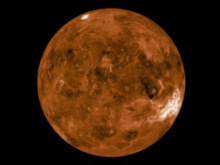Our website is made possible by displaying online advertisements to our visitors.
Please consider supporting us by disabling your ad blocker.
Surface features of Venus

The surface of Venus is dominated by geologic features that include volcanoes, large impact craters, and aeolian erosion and sedimentation landforms. Venus has a topography reflecting its single, strong crustal plate, with a unimodal elevation distribution (over 90% of the surface lies within an elevation of -1.0 and 2.5 km)[1] that preserves geologic structures for long periods of time. Studies of the Venusian surface are based on imaging, radar, and altimetry data collected from several exploratory space probes, particularly Magellan, since 1961 (see Venus Exploration). Despite its similarities to Earth in size, mass, density, and possibly composition, Venus has a unique geology that is unlike Earth's. Although much older than Earth's, the surface of Venus is relatively young compared to other terrestrial planets (<500 million years old), possibly due to a global-scale resurfacing event that buried much of the previous rock record.[2] Venus is believed to have approximately the same bulk elemental composition as Earth, due to the physical similarities, but the exact composition is unknown. The surface conditions on Venus are more extreme than on Earth, with temperatures ranging from 453 to 473 °C and pressures of 95 bar.[3] Venus lacks water, which makes crustal rock stronger and helps preserve surface features. The features observed provide evidence for the geological processes at work. Twenty feature types have been categorized thus far. These classes include local features, such as craters, coronae, and undae, as well as regional-scale features, such as planitiae, plana, and tesserae.[4]
- ^ Ford, P.G.; Pettengill, G.H. (Aug 25, 1992). "Venus topography and kilometer-scale slopes". Journal of Geophysical Research: Planets. 97 (E8): 13103–13114. Bibcode:1992JGR....9713103F. doi:10.1029/92JE01085.
- ^ Basilevsky, A.T.; Head, J.W.; Schaber, G.G.; Strom, R.G. (1997). The resurfacing history of Venus (in Venus II, eds. Bougher, S.W. et al.). The University of Arizona Press. pp. 1047–1084. ISBN 0816518300.
- ^ Taylor, S.R.; McLennan, S.M (2010). Planetary Crusts: Their composition, origin, and evolution. The Cambridge University Press. pp. 181–206. ISBN 9780521841863.
- ^ Tanaka, K.L.; Senske, D.A.; Price, M.; Kirk, R.L. (1997). "Physiography, geomorphic/geologic mapping, and stratigraphy of Venus" (in Venus II, eds. Bougher, S.W. et al.). The University of Arizona Press. pp. 667–694. ISBN 0816518300.
Previous Page Next Page


